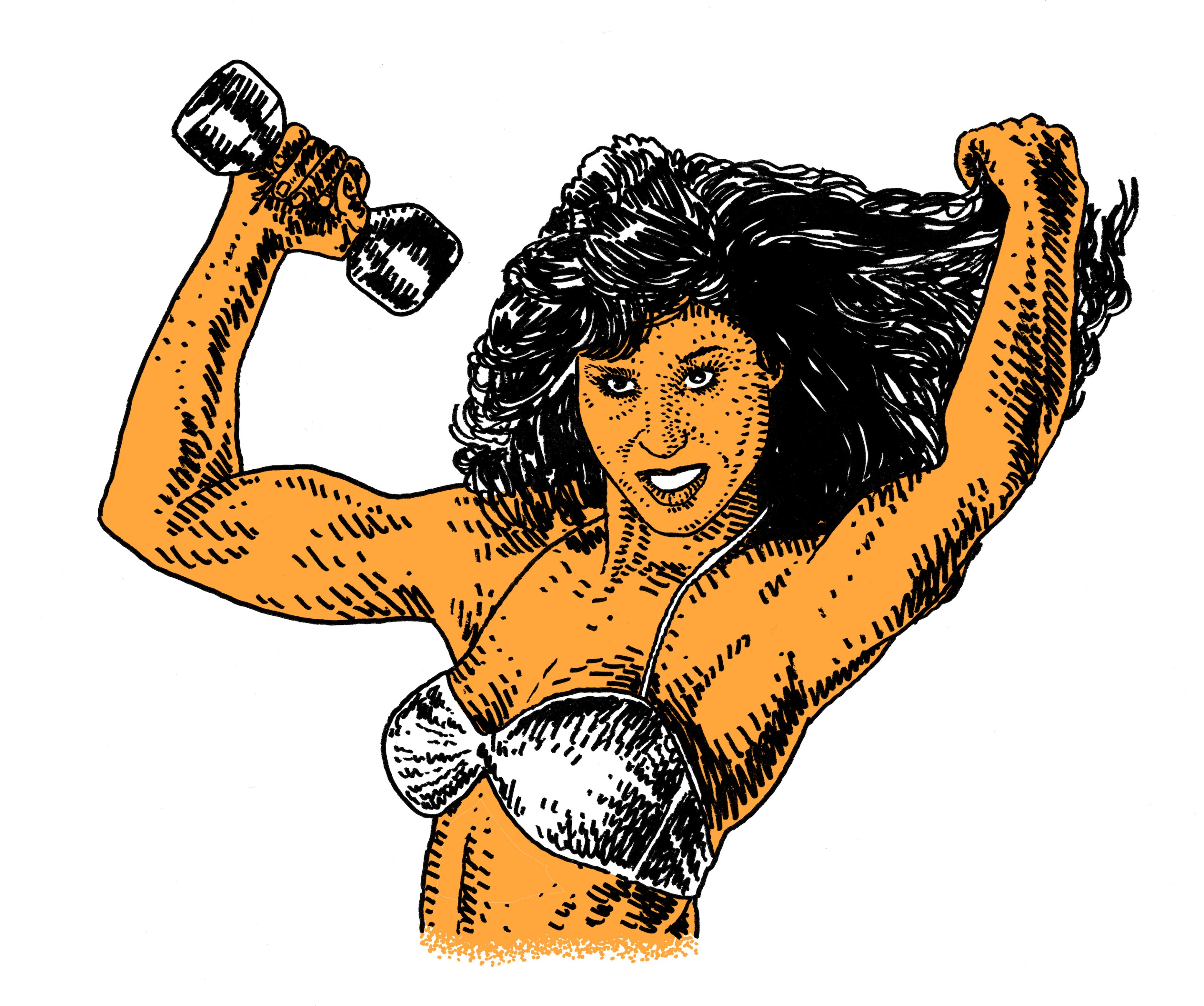This is our monthly cross-post from the Sports Stories newsletter. It’s written by Eric Nusbaum and illustrated by Adam Villacin, and focuses on overlooked or forgotten stories from sports history. We like it very much, and if you’d like to become a subscriber you can do so by signing up here.
Many of you are probably aware of the 1977 documentary Pumping Iron, which made stars out of bodybuilders Arnold Schwarzenegger and Lou Ferrigno as they battled for the title of Mr. Olympia. Or perhaps you have at least come across the infamous scene in which California's future governor gleefully discusses what specifically lifting weights feels like.
I am willing to bet that fewer readers are familiar with its sequel, Pumping Iron 2: The Women. Produced, written, and directed by some of the same folks who made the original, Pumping Iron 2 is a weird time capsule into the 1980s and also a surprisingly direct (if also dated, clumsy, and limited) exploration of gender. It’s an interesting movie and certainly a sports story worth thinking about.
The documentary tells the tale of the 1983 Caesars World Cup, a bodybuilding event that was specifically invented for the sake of the movie. (This also pushes us to consider where the line falls on what exactly we might call a documentary; or, if you want to go even further, the artifice that is inherent in all the sporting events we care about so deeply.) Regardless, the characters are real and the competition is real to the women competing in it.
We meet various bodybuilders as they prepare for the event, visiting them at home, in the gym, etc. There are lots of closeups of muscles and bodies, lots of shots of the neon lights of Las Vegas. There are nice little scenes showing the athletes in their daily lives, with their families. But the film is primarily interested in addressing a fundamental question about the nature of bodies themselves, and how we judge them.

How does it address this question? Well, the filmmakers bring in a ringer. In addition to the typical members of the bodybuilding circuit, the Caesars World Cup will also feature a charming Australian weightlifter named Bev Francis. Francis is stronger and more muscular than her competitors. But she also lacks the traditionally “feminine” qualities that judges in bodybuilding competitions look for.
The question then becomes: What is the purpose of a bodybuilding contest? Is it about having the most muscles? Is it about practical strength? Is it a purely aesthetic exercise? And if so, what is the basis for these aesthetics?
In the narrative, Francis is pitted in particular against the “feminine” Rachel McLish. McLish stands in for what the judging establishment expects from its competitors. Francis challenges their preconceived notions and expectations. It’s worth stating here that I am discussing femininity in the terms of the documentary, which are pretty binary and unimaginative. It’s also worth noting that both women come off in the movie as extremely likable, self-aware athletes. They are reflective, contemplative, and also funny. So is Carla Dunlap, a former synchronized swimmer turned bodybuilder who tells her family early in the movie that she is really all about one thing: winning.
The problem is that winning a competition is hard when the rules are up in the air even as it is going on. There is a level of subjectivity, of course, to all judged sporting events: figure skating, gymnastics, bodybuilding. But in Pumping Iron 2, that subjectivity becomes a pivotal plot point.
Right before the competition in Vegas, officials meet to discuss the criteria by which the women will be judged. Nearly all of these officials, it should be noted, are men.

“We hope that this evening, we can clear up the definite meaning ... of the word femininity,” says the judge who appears to be in charge. This is a pretty heady task for a panel of bodybuilding judges in a competition that was invented for the sake of a movie sequel. Needless to say, no consensus is reached, and at least in the movie, no women’s voices are heard.
This main judge fellow, who is not named, argues that if women become too muscular they lose their femininity. His opponents argue that like anything else, femininity is in the eye of the beholder, and besides that, femininity is not the point of a bodybuilding competition. The point of a bodybuilding competition is muscles.
“It’s as though we told women skiers they can only ski so fast,” one says.
When the competition begins, it is clear that Francis, the most muscular woman in the group, has the crowd behind her. She emerges on a dark stage, and poses to a synth version of the music from 2001: A Space Odyssey. It’s dramatic, ridiculous, and deeply entertaining. The people go wild. The entire competition, as it is filmed, has a surreal quality to it. One woman, Tina Plackinger, literally moonwalks between poses.
In between rounds of poses, Bev Francis and wonders about the nature of the sport, and the whims of judges, and the point of all this. “You’re not allowed to have muscles, you’re a girl,” she says in the voice of a judge. Francis is a spectacular athlete. She has proven that with enough willpower and discipline a human body can do just about anything.
Is bodybuilding a more honest sport for the fact that it is really just about judging looks? After all, aren’t appearances the reason so many people spend so much time in the gym? Or is it just an exercise in our collective vanity? A reminder of our collective narrowmindedness and the limits of conventional thinking about gender? Bev Francis had already achieved greatness in powerlifting. She had already demonstrated her functional strength. Why stoop to being judged by strangers for the mere appearance of said strength? Especially strangers who are so bound by absurd and indefensible and ultimately empty notions of what “beauty” is.
When the finalists are announced by emcee George Plimpton—yes, the writer and founder of The Paris Review—the moonwalking Tina Packlinger is among them. So are Rachel McLish and Carla Dunlap. But not Bev Francis. It is Dunlap who is announced as the winner. Bev Francis, it turns out, finished in eighth place.
After the competition, the women all eat ice cream together backstage to celebrate being done with training—done with fasting and being leered at and putting themselves through hell.
But Bev Francis gets the last word.
We see her back in her hotel room, discussing the loss with her trainers. Finally, the camera cuts to one of the trainers—a bodybuilder himself.
“What did Tina Plackinger have over Bev? What did Carla have over Bev?
"Explain it to me. Explain it to me. Explain it to me.”
Related Reading
You can watch a low-quality stream of Pumping Iron 2: The Women here.
I also thought this writeup on the film by Peter McGough of the website Muscular Development was really good. He explores the extent to which the competition is contrived and also points out that Francis and McLish were actually close friends, despite the way the film tried to portray them as rivals.
Here are a couple reviews of the film by Roger Ebert, who liked it, and Janis Maslin, who did not.
Finally, these questions are still lingering in the bodybuilding world. When I worked at Vice we published a feature by Ian Frisch on the pressure put on women bodybuilders to get breast implants.





